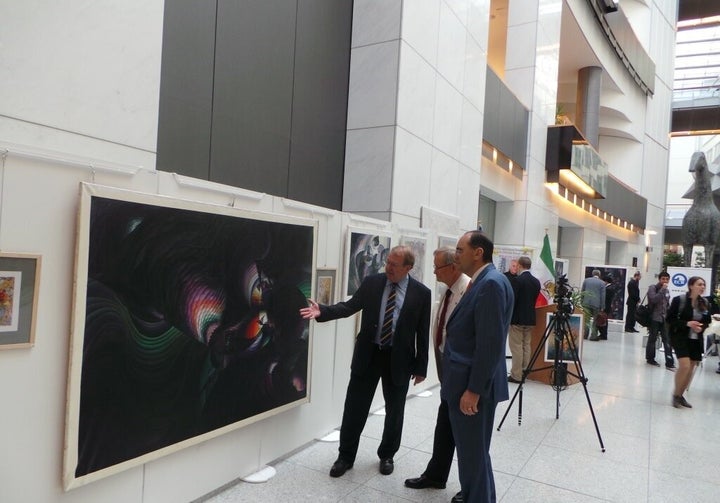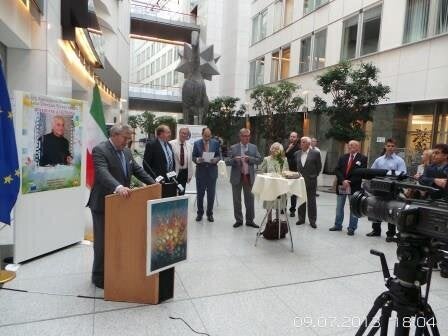On 9 July, 2013, the European Parliament hosted an exhibition showcasing the works of the late Iranian modern artist, Bahram Alivandi. The gallery included a wide variety of Alivandi's paintings and tapestries demonstrating his unique style which blends elements of classical Persian art with modern techniques. Alivandi's art is not only distinct in style, but is noteworthy for its political nature, focusing on themes of resistance and fighting against injustice. These themes defined Alivandi as an artist and as an individual.

Alivandi was born in Fars Province in 1928, and gained his artistic training in Tehran, initially at the Kamal-ol-Molk Academy of Art, as well as French masters at Tehran's School of Fine Arts, from which he graduated with distinction. He completed a further degree in painting at the College of Decorative Arts, Tehran. In 1959 he was given a position teaching painting at the Workshop of National Art by the Ministry of Education, which he held for 20 years.
During his time in Iran, Alivandi was one of the nation's leading modern artists. After the 1979 revolution, he soon faced the artistic censorship and brutality of Khomeini's regime. Due to the repressive climate he escaped Iran and moved to Vienna in 1983. Alivandi joined the National Council of Resistance of Iran (NCRI) in 1994, and was a member of this parliament in exile until his death on May 12, 2012.
The exhibition was organised by Polish Euro MP Ryszard Czarnecki from European Conservatives and Reformists group (ECR), who began the reception by stating that "Bahram Alivandi to me is a hero who will go down in the history of Iran for many generations to come. This talent and human expressions and his style are all very special and unique."

The event included appearances by two Vice Presidents of the European Parliament. Vice President Alejo Vidal Quadras from Spain noted "Alivandi was not just a brilliant artist and painter; he was also a man who said no to dictatorships." Oldřich Vlasák Vice President of European Parliament from the Czech Republic added that "Alivandi was forced to exile, but he never lost hope to return to a free Iran. His two sons have been members of the Iranian resistance for many years and are in Camp Liberty now, and I would like to salute them both from here."
Scottish MEP Struan Stevenson, chairman of Friends of a Free Iran Intergroup in European Parliament also praised Alivandi's work and commitment to fighting for freedom saying, "This exhibition, brought here from Vienna by Mr Alivandi's widow Nahid, is a tribute to his life of devotion to freedom and democracy. It is a tribute to the bravery of his two sons and to the 3,200 people of the Iranian resistance who are incarcerated in appalling conditions in those camps in Iraq. It is also a tribute to the NCRI under the leadership of Mrs Maryam Rajavi and their struggle to bring freedom and democracy to Iran."
Stephen Hughes, First Vice President of the Socialists and Democrats group in European Parliament (S&D) said, "This is a unique and remarkable exhibition, a melding of different techniques of Persian and oriental influences mixed with modern western techniques". He added that "Bahram Alivandi was a remarkable man in many ways. He had a firm belief in social justice and democracy which led to his imprisonment during the years of the Shah and also led to his harassment during the rule of the mullahs".
Tunne Kelam, MEP from European People's Party Group (EPP) from Estonia said that Alivandi was a victim of the "mullahs' terrorist regime" because "he was not able to express his feelings and ideas freely under dictatorship."
Romana Jordan, MEP from Slovenia said that she admired Alivandi's achievement and mentioned that artists are always the "first victims of denial of freedom of expression." She added: "This exhibition is a human message to the world that freedom of each and every individual is far more important than economic or other benefits."
Also present was Alivandi's widow Nahid Hematabadi, who said that Alivandi was "born as an artist," and that more than anything he was "a great human being".
Other MEPs present at the reception included Anna Záborská, Jan Kozłowski, Sampo Terho, Algirdas Saudargas, Kartika Liotard, Petri Sarvamaa, Francisco Sosa Wagner, Glenis Willmott, and Sajjad Karim.
The paintings on display showcased the variety of Alivandi's techniques, including works which were done in a cubist style as well as his own unique pointillist techniques. The gallery ran for two days and was well received by a large audience from the European Parliament.
